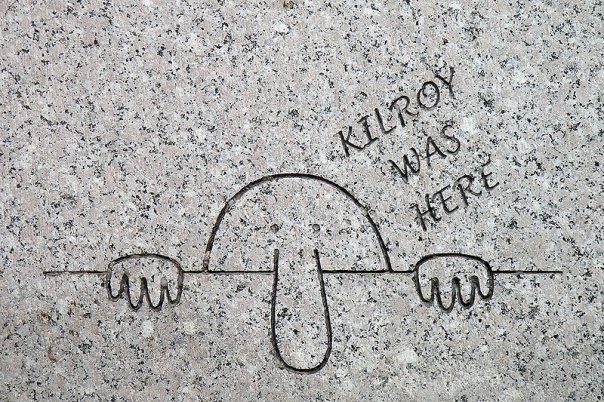Kilroy Was Here
January 30, 2010
Kilroy
was here is an American popular culture expression, often seen in
graffiti. Its origins are open to speculation, but recognition of it and
the distinctive doodle of "Kilroy" peeking over a wall is known almost
everywhere among U.S. residents who lived during World War II and
through the Korean War.
The "Kilroy was here" phrase appeared everywhere during World War
II, but its origin did not become widely known until after the war had
ended.
In 1946 the American Transit Association ran a contest to find out
where and why the phrase originated. As it turned out, the winner was
James J. Kilroy of Boston. It seems as if Kilroy was hired by Fore River
shipyard on December 5, 1941 as a checker. His job was to count the
rivet holes and then leave chalk marks where he had left off. It was on
this basis that the riveter's piece of work was calculated.
Some of the riveters were not too honest and would erase the mark
left by Kilroy. Thus, some of the rivet holes were counted twice. Kilroy
got wind of this devious practice and proceeded to scrawl "Kilroy was
here" on his rounds.
He reportedly left his mark on such famous Fore River vessels as the
battleship, Massachusetts, now berthed permanently at "Battleship
Cove", Fall River, Massachusetts, the Carrier, Lexington (II), and the
heavy cruiser, Baltimore, as well as numerous troop carriers.
Kilroy had marked the ships themselves as they were being built—so,
at a later date, the phrase would be found chalked in places that no
graffiti-artist could have reached (inside sealed hull spaces, for
example), which then fed the mythical significance of the phrase—after
all, if Kilroy could leave his mark there, who knew where else he could
go?
In later life Kilroy became a Boston City Councillor and state representative. He died on November 26, 1962.
There are many urban legends attached to the Kilroy graffiti. One
states that Adolf Hitler believed that Kilroy was some kind of American
super spy because the graffiti kept turning up in secure Nazi
installations, presumably having been actually brought on captured
Allied military equipment. Another states that Stalin was the first to
enter an outhouse especially built for the leaders at the Potsdam
conference. Upon exiting, Stalin asked an aide: "Who is this Kilroy?"
Another legend states that a German officer, having seen frequent
"Kilroys" posted in different cities, told all of his men that if they
happened to come across a "Kilroy" he wanted to question him personally.
The graffiti is supposedly located on various significant or
difficult-to-reach places such as on the torch of the Statue of Liberty,
on the Marco Polo Bridge in China, in huts in Polynesia, on a high
girder on the George Washington Bridge in New York, at the peak of Mt.
Everest, on the underside of the Arc de Triomphe, scribbled in the dust
on the moon, in World War II pillboxes scattered around Germany, on a
tile in the bathroom of a Grainger in Baltimore, and around the sewers
of Paris.
In tribute to its origin, 'Kilroy Was Here' is engraved in the
National World War II Memorial in Washington, D.C. (see the photo below)



